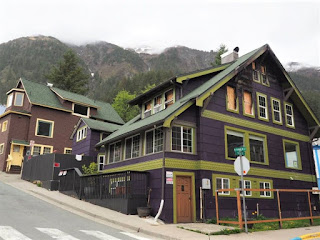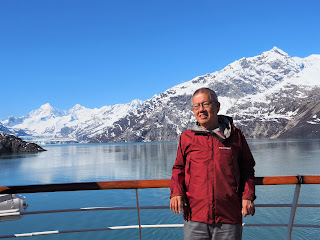North to Alaska in 2019
(Travel Story Series @ Hon Too Fang 2021)
In May 2019 we joined a cruise to tour Alaska, or a tiny part of it.
Alaska: Info
Alaska is the 49th state of the USA, separated from the mainland by Canada. It is 5.2 times the size of Malaysia and has a population of 630.000. The main city is Anchorage with 290,000 people. The oil and gas industry contributes 80% of the economy. Besides oil and gas, the main export is seafood.
History of Alaska
Numerous indigenous peoples occupied Alaska for thousands of years before the arrival of Europeans. The Russians were believed to be the first to come, starting in the mid-1600s. They formed the Russian American Company in 1799 to start trade and settlement in this region. But it was not particularly profitable. In 1867, Russia sold their interest in Alaska to the United States for a sum of US$ 7.2 million. In 1912 it became a colony of the US, and in 1959 became the 49th state of the USA.
(Note in 2021: The whole of Alaska was sold for only US$ 7.2 million in 1867. Not sure if the original purchase was "willing buyer, willing seller" or not, or with cannons waiting outside the negotiation room. Today in New York City, the most expensive apartment, the 5-storey, 20,000 sq ft penthouse unit, Le Penthouse is worth US$ 97 million.)
The Alaska Cruise
Along the coast in the southern strip, there are rugged fjords, glaciers, lush forests, and a variety of wildlife to attract visitors. And the only way to see them is via ships, hence the flourish of the cruise industry. There are some 2 million cruise-ship visitors a year, impacting the local economy significantly.
Most of the cruise ships ply on a route called the Inside Passage. The route extends from the southern strip of Alaska, through western British Columbia in Canada, to north-western Washington in the United States. Ships using the route could avoid bad weather in the open ocean and tourists could visit some of the many isolated communities along the route. Maps to show where Alaska is and our cruise route of the Inside Passage.
The Cruise Ship
Of course there are many varieties of cruises. A common one is the both-way cruise from the city of Vancouver in Canada or the city of Seattle in the US. Then there are one-way cruise plus return by air to/from the city of Anchorage, etc.
We joined a 7-day all-cruise type departing from Vancouver. Our cruise ship is named "Volendam", owned by the Holland America Lines. It is 8 stories high, with a guest capacity of 1,432 on double occupancy. Shown some views of the open deck, with a mini basketball court, good for 1 on 1.
First 2 Days
By noon on 07/05/19 we boarded our cruise ship at the Canada Place in Vancouver, a building designed to look like a sail boat, with photos taken from 2 different sides.
We are on a standard cabin, well-furnished and equipped, about 280 sq ft in size. Shown also the never ending narrow corridor.
The 1st 2 days were cruising days, at speeds around 40 km an hour. Quite monotonous scenes with low mountains in the distance. We were confined to the ship, enjoying the endless rounds of food and some facilities, like free cooking classes, movies, live bands, etc. Shown a lounge area to relax, library and game room, and of course the money spinning slot machines. However the slot machines had few patrons, may be there were very few Chinese passengers. There were morning masses for the Catholics, held at a small theatre. Shown with the priest under the spot light of the theatre. Attendance around 30 to 40.
Juneau
Around 1 pm on the 3rd day the ship docked at the 1st port of call, Juneau, the capital city of the state of Alaska. Population only 32,000. The major industries are government service, tourism and fishing. It was a gloomy, cloudy day with occasional light drizzles. We spent about 3+ hours in town. Juneau is only accessible by ships. There is no road link to any other place.
Views of the shoreline near to the port, the quay area of Juneau, the State Capital Building and a statue of the iconic brown (Kodiak) bear. The statue in front of the state building is that of U.S. Secretary of State, William Seward, who arranged the purchase of Alaska from the Russians in 1867.
Then the St Nicholas Russian Orthodox Church, built in 1893, a funny signboard at a bus stop (listing of what you want to do before you die), typical houses and roadside tulips in bloom.
We spent an hour at the Alaska State Museum, the main collections being cultural material from the indigenous people living here before the arrivals of the Russians and Americans. The section on masks is fascinating. The last photo shows a piece of modern art: creation of a giant octopus using cans and paper cups, etc.
Alaska is of course famous for the Alaskan king crabs. A single leg cost US$ 28 or around RM 116. So for 2 legs we had to pretend they cost only RM 56 instead of US$ 56. Each leg came with a small cup of French fries.
Skagway
On the 4th day the ship docked at the town of Skagway with 1,000 residents. A town founded during the Krondike Gold Rush of 1896-1899, now a regular stop for cruise ships.
A few words about the Klondike Gold Rush - it is a migration by an estimated 100,000 prospectors to the Klondike region in Yukon, a territory in north-western Canada, between 1896 and 1899. Gold was discovered there by local miners in 1896, it triggered a stampede of prospectors from the south. Many took the route through the port of Skagway. Here, they followed either the Chilkoot or the White Pass trails to the Yukon River, and sailed down to the Klondike region.
Scenes of Skagway: surrounded by snow-capped mountains, the main street with the jewellery and liquor stores and hotels, a giant railway snow blower and the centennial statues, a monument commemorating the role of Alaska's native guides in the Klondike Gold Rush, erected in 1997. During the gold rush days the prostitutes advertised themselves at the 1st floor windows. Enacted here to advertise a show.
We also took up a half-day Yukoner coach tour, costing US$ 72.50 each. It is the popular route of the prospectors during the Krondike Gold Rush. The coach took us from Skagway along the White Pass route into British Columbia in Canada, reached the Yukon border and returned.
Shown our bus and scenes of the very rugged terrain.
At the White Pass Summit (873 m) near the Canadian border, it was snowing very slightly for a short while. "Old" snow did cover most of the rough terrain.
Further north the route followed the long Tutsui Lake, very scenic, until we reached the border with Yukon, a territory of Canada. There are two nearby signboards, one on Alaska to welcome tourists from the Canadian side and one on Yukon, for those from the Canadian side. With us is CL.
Glacier Bay
The 5th day is cruising day, around the region called Glacier Bay. The photos are taken at the John Hopkins Inlet where the ship came very close to land, on a beautiful sunny day.
Ketchikan
On the 6th day the ship docked at Ketchikan, population 8,000, the southernmost town in Alaska. The name is said to mean "Thundering Wings of an Eagle", with a giant eagle statue at the waterfront. The neighbourhood is heavily forested, with nice houses on the slope, and a monument in the town centre.
It is a popular cruise ship stop. Today 4 are docked here. Shown the giant "Norwegian Joy" which could carry 3,883 passengers. It is almost touching our ship.
Downtown is a National Historic District. It is also a salmon centre, the 2nd photo showing Ketchikan Creek, a salmon passageway and lookout point. The step-like structure on the left of the photo is the salmon ladder to help salmon to ascend a stream. More scenes in town, like having a cup of coffee to enjoy free wifi. Rhododendrons are blooming.
Ketchikan has the world's largest collection of standing totem poles, found throughout the city and at four major locations. We visited one of the locations, the Totem Heritage Centre, a treasure house of historic and famous totems, unrestored as well as restored. Totem poles are monumental timber carvings with figures or symbols, made by the indigenous people in the north-west coast of the North American continent.
Last Day
The 7th day is again cruising day and the last day too. It has to be noted that there are marine life to see on the trip, from whales and dolphins to sea lions and harbour seals, etc. But we were not equipped for that, like binoculars.
There is no free wifi on the ship. You had to pay: about US$ 80 for the 7-day duration. And you can’t share it too. Your sharing feature in the mobile phone is disabled by their application software. Could anyone go without wifi for a week? Wife yes, wifi, no.
Lastly about food on the ship. Food is available like 20 hours a day, mostly buffets. Generally free except special dinners where one have to pay a surcharge. Breakfast by the window is relaxing, 1st photo. The desserts are particularly good. Shown also a decoration at the bar.
Ending
On late morning, we disembarked in Vancouver. The Alaska Cruise is essentially ended. May be we could enjoy the Johnny Horton hit "North to Alaska" to end the story. I do. Click on the link below.
https://www.youtube.com/watch?v=RO6IU9RpjS8
(First written in May 2019 in the form of a daily WhatsApp report. Lightly revised to this PDF format in May 2021)





































































No comments:
Post a Comment